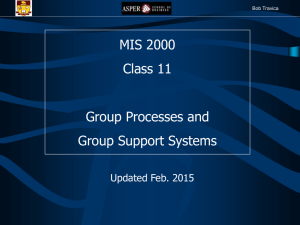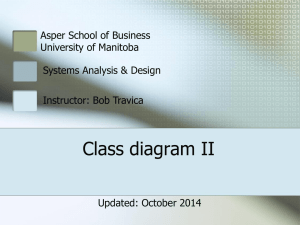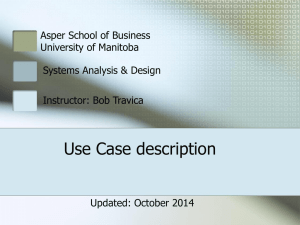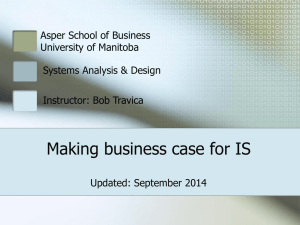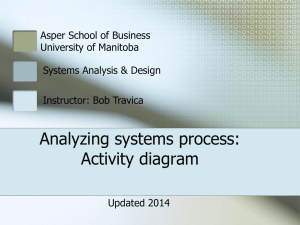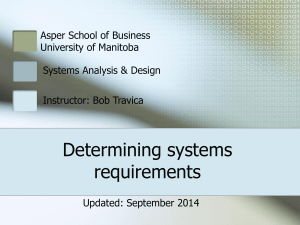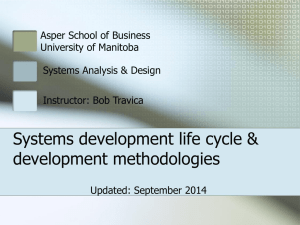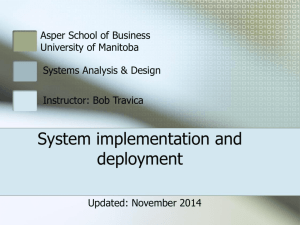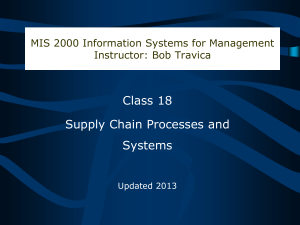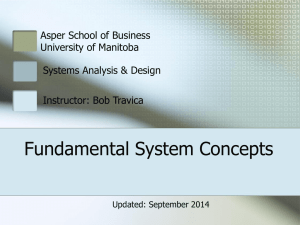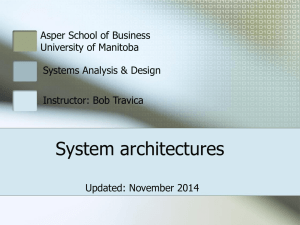Group Processes and Group Support
advertisement
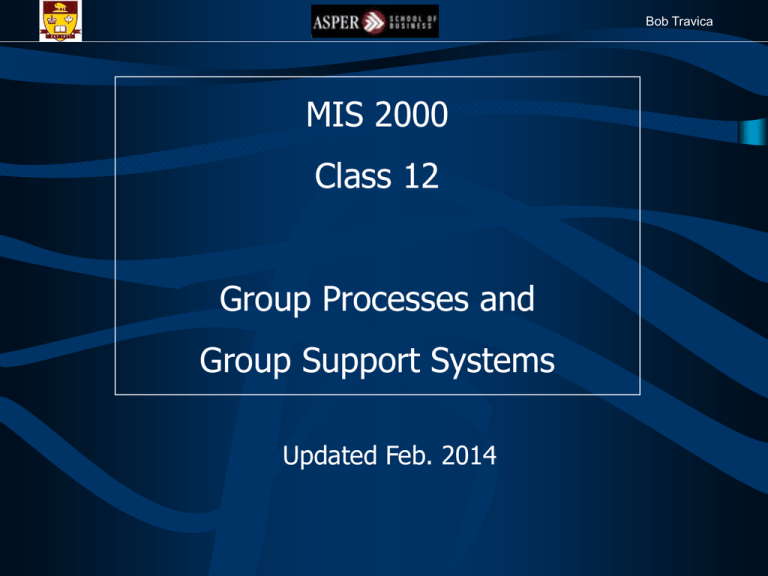
Bob Travica MIS 2000 Class 12 Group Processes and Group Support Systems Updated Feb. 2014 Bob Travica Outline • Workgroup (Team) Concepts • Project Team • Group Support Systems (Types, examples) • Team-Based Organization (case of Protegra) • Distributed Teams • Summary 2 of 11 Bob Travica Workgroup Concepts • Workgroup or team: - Collection of people working together on a specific task for a defined period of time. - Team is an organization in small with a shorter life span. - An organization can be team-based (e.g., Protegra; slide 8). • Key aspects: - Task: What needs to be done Work roles: Who does what Timeline: Start and end point, landmarks, schedule More… 3 of 11 Bob Travica - Members depend directly on each other – interdependence: can be sequential, parallel, reciprocal. - Group could do more than an individual – synergy But there may be problems in teamwork: - some members do not put in their part (free ride) - members accept mainstream thinking without reasoning (groupthink) - Success conditions: member composition, communication, leadership - Team types based on location: same location (collocated team) vs. different (distributed team) 4 of 11 Bob Travica Project Team • Project Team (PT) is a kind of team that performs in fundamental production processes (see case later). • PT has a key role in project-driven organizations (research, marketing, construction, public accounting, software development) • PT has lots of autonomy as it manages work, money, time. • PT disbands when project ends. 5 of 11 Bob Travica Team life cycle • A set of complex activities (phases) from team formation to team’s delivery of product and disbanding. • Each complex activity is a process in itself: 1. Set team task Define goals and timeline Allocate budget Select members 2. Align on mission Define roles Establish leadership 1. Forming 5. Disbanding Focus for IS 4. Performing 2. Storming 3. Norming Developing/Using Group Mind 3. Create project documentation (charter, plans, timelines) Make appointments Set communication means More 6 of 13 Bob Travica Team life cycle (cont.) 4. Execute project tasks Socialize Deliver product - Execute project activities: a sub-process of connected work activities that are constrained by a precise timeline and budget allowances. * 5. Create final reports Reflect on & Record experiences Close Project 1. Forming 5. Disbanding Focus for IS 4. Performing 2. Storming 3. Norming Developing/Using Group Mind 7 of 13 Bob Travica Group Support Systems • Support the Performing phase (process) in the team life cycle. 1. Project Management Systems (PMS): Protegra – see slides; PMS covers: activities, people, time, financials (tracking work hours, expenses), management of versions of developed software, and sharing of project documentation. A team project is planned as a process that consists of tasks. Tasks employ team members, and area executed in time. Costs are incurred for people and material resources used in tasks. Data diagram for project plan Project contains Task deploys has Account allocated to employs Employee Resource More… 8 of 11 Bob Travica Activity Time John John Jean People Jean, Alex Alex Money: Hourly rate is entered in a separate sheet for each person, and the system multiplies it by planned time entered in this sheet. With the progress function, the budget balance is tracked. PMS generates many reports automatically. Output from PMS showing plan and possibly execution of project. This output can be presented as the standard process diagram. More… 9 of 13 Bob Travica – Boeing-Rocketdyne - Internet Notebook PMS • Project: Developing an economical type of rocket engine in 10 months • Distributed team made of engineers from Boeing and two partners; Very successful outcome: new engine design, much simpler and cheaper to make; project under budget. • GSS supporting the team: Internet Notebook (repository of design documentation with online access via laptops, email notifications on project progress, hypertext links on useful learning sources). • Functions that required more time & effort were used less documenting new knowledge and indexing the documents. This outcomes ran against managers’ expectations. created in Project Document Rocket Engine Project tracked via Email supported by Linked learning source 10 of 13 Bob Travica Group Support Systems • 2. File Sharing (e.g., Google docs, university class support systems; used also in PMS and in knowledge management processes) • 3. Application Sharing (sharing screen and programs; figure below); engineers and other professionals using visual expression. 11 of 13 Bob Travica Group Support Systems 4. Workflow Support Systems * • 5. Communication for collaboration and knowledge sharing • (e.g., private email, el. bulletin boards, chat) 6. Group Decision Support System (group brainstorming and option selection via GDSS; fig. below). Used extensively at IBM. ** NOTE: This system also belongs to decision making systems. Facilitator – stirs the session Decision makers – team or ad-hoc group 12 of 13 Bob Travica Team-Based Organization • Team-Based Organization is one in which project team is the basic unit. In contrast, in other types of organization the basic unit is department. • Research organizations, public accounting, consulting, software. • Company Protegra – Winnipeg-based, consulting on management and IS (software creation).* • Project team at Protegra has 3-5 members. Team roles** are divided but key decisions are made collectively. This is part of Protegra’s culture. • Other cultural beliefs and behaviors: professionalism, fair contribution to project work, open communication, knowledge sharing, respect for others. More 13 of 13 Bob Travica Distributed Teams* • Challenges for distributed teams: o Aligning workflows over space & time; IS for communication and work support are necessary o Following same values and norms o Maintaining trust in others and their work o Time synchronization o Effective communication; should be approached as process at detailed level (timing, turn taking, checks, effectiveness for all involved – many customers); selection of channels should fit task (systems-supported vs. face-to-face) 14 of 13 Bob Travica Summary • Workgroup (Team) is a Collection of people working together on a specific task for a defined period. • Some key aspects for teams: interdependence, synergy, composition, communication, leadership. • Project team plays key role in project-driven organizations. • Team life cycle is a process that consists of five sub-processes. • GSS include project management system, file sharing, applications sharing, workflow system, communication systems & Group Decision Support System. • Team-based organization is one in which project team is the basic unit (differentiate from org. using team as a work method). Culture and systems support crucial. • In a distributed (“virtual”) team members work at different locations. • To align distributed team's workflows over space and time, culture and communication processes & systems are crucial. 15 of 13
